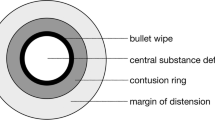Abstract
In the past, the presence of textile fibres in the bullet track of gunshot injuries in body regions covered with clothes was used to differentiate between entrance and exit wounds; as with handguns, a displacement of textile fibres was considered possible only in the direction of the shot. In the present study, the transfer of textile fibres from the entrance and exit regions into the bullet path was systematically investigated with the help of a skin-gelatine composite model. For this purpose, the skin of the bullet entrance and exit region was covered with textile fabric (jeans or jersey material), before conducting four test series of ten test shots each firing a 9-mm Parabellum full-jacketed projectile from a distance of 2 m. The length of the bullet track was 25 and 8 cm, respectively. Subsequently, the bullet tracks were microscopically investigated in sections for the presence of textile fibres. In all the investigated bullet tracks, textile fibres both from the entrance and exit regions could be demonstrated. The distribution pattern depended on the length of the bullet path and the extension of the temporary cavitation. The results are discussed in relation to the relevant literature.






Similar content being viewed by others
References
Casper JL (1858) Handbuch der gerichtlich-medizinischen Leichen-Diagnostik, 2nd edn. August Hirschwald, Berlin, p 295
Czymek R, Lenz S, Dusel W (1999) Prevention of infection in war wounds. Chirurg 70:1156–1162
Di Maio VJM (1999) Gunshot wounds, 2nd edn. Elsevier, New York, pp 336–345
Große Perdekamp M, Vennemann B, Mattern D, Serr A, Braunwarth R, Pollak S (2005) Tissue defect at the gunshot entrance wound: what happens to the skin? Int J Legal Med 119:217–222
Grosse Perdekamp M, Kneubuehl BP, Serr A, Vennemann B, Pollak S (2006) Gunshot-related transport of micro-organisms from the skin of the entrance region into the bullet path. Int J Legal Med 120:257–264
Jacob E, Setterstrom JA (1989) Infection in war wounds: experience in recent military conflicts and future considerations. Mil Med 154:311–315
Jussila J (2004) Preparing ballistic gelatine—review and proposal for a standard method. Forensic Sci Int 141:91–98
Kage S, Kudo K, Kaizoji A, Ryumoto J, Ikeda H, Ikeda N (2001) A simple method for detection of gunshot residue particles from hands, hair, face, and clothing using scanning electron microscopy/wavelength dispersive X-ray (SEM/WDX). J Forensic Sci 46:830–834
Meixner K (1923) Schußverletzungen durch Handfeuerwaffen. Arch Kriminol 75:82–108
Owen-Smith MS (1981) High velocity missile wounds. Edward Arnold, London, pp 22–42
Pollak S (1982) Zur Makro- und Mikromorphologie der durch Faustfeuerwaffen erzeugten Einschußwunden. Beitr Gerichtl Med 40:493–520
Pollak S, Stellwag-Carion C (1988) Morphologische Besonderheiten bei absoluten Nahschüssen auf bekleidete und bedeckte Körperregionen. Beitr Gerichtl Med 46:401–407
Sellier K (1982) Schußwaffen und Schußwirkungen I. Ballistik, Medizin und Kriminalistik, 2nd edn. Schmidt-Römhild, Lübeck, pp 230–231
Sellier KG, Kneubuehl BP (1994) Wound ballistics and the scientific background. Elsevier, Amsterdam, pp 192–197
Spitz WU (2006) Gunshot wounds. In: Spitz WU (ed) Medicolegal investigation of death. 4th edn. Charles C Thomas, Springfield IL, pp 607–705
Straßmann G (1919) Versuche zur Unterscheidung von Ein- und Ausschuss. Arch Kriminol 71:308–319
Teige K, Jahnke R, Gerlach D, Kempers B, Fischer M (1986) Die Verteilung textiler Fasern im Schußkanal. Z Rechtsmed 96:183–197
Tian HM, Huang MJ, Liu YQ, Wang ZG (1982) Primary bacterial contamination of wound tract. Acta Chir Scand [Suppl] 508:265–269
Vennemann B, Grosse Perdekamp M, Kneubuehl BP, Serr A, Pollak S (2006) Gunshot-related displacement of skin particles and bacteria from the exit region back into the bullet path. Int J Legal Med 121:105–111
Author information
Authors and Affiliations
Corresponding author
Rights and permissions
About this article
Cite this article
Vennemann, B., Dautel, F., Braunwarth, R. et al. Textile fibres along the bullet path – experimental study on a skin-gelatine composite model. Int J Legal Med 122, 213–218 (2008). https://doi.org/10.1007/s00414-007-0221-3
Received:
Accepted:
Published:
Issue Date:
DOI: https://doi.org/10.1007/s00414-007-0221-3




